2012 Hyundai Sonata Hybrid battery
[x] Cancel search: batteryPage 389 of 403
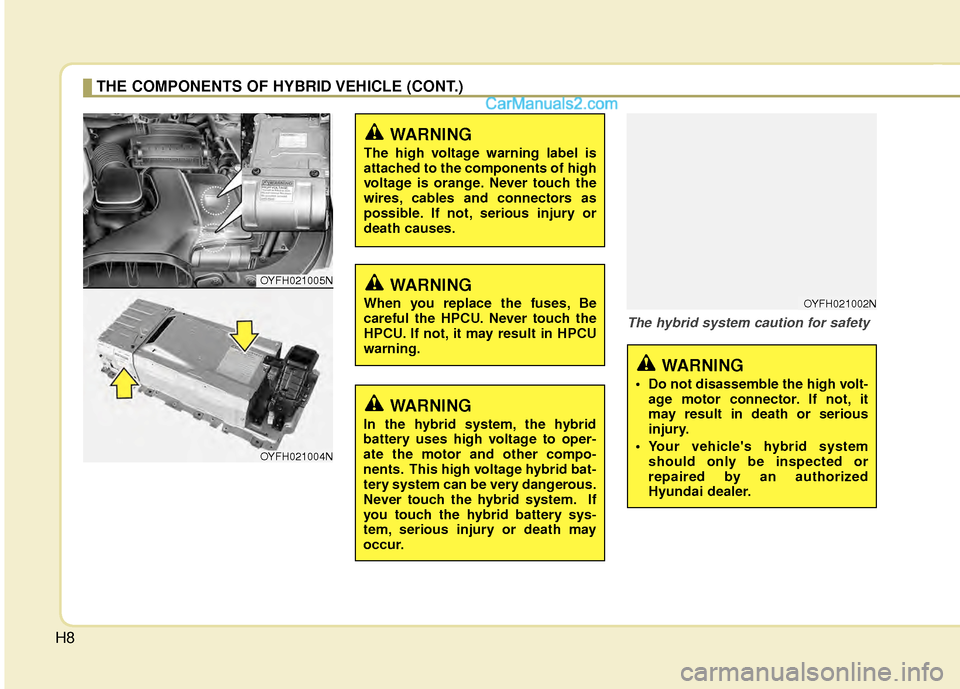
H8
The hybrid system caution for safety
THE COMPONENTS OF HYBRID VEHICLE (CONT.)
WARNING
In the hybrid system, the hybrid
battery uses high voltage to oper-
ate the motor and other compo-
nents. This high voltage hybrid bat-
tery system can be very dangerous.
Never touch the hybrid system. If
you touch the hybrid battery sys-
tem, serious injury or death may
occur.
WARNING
The high voltage warning label is
attached to the components of high
voltage is orange. Never touch the
wires, cables and connectors as
possible. If not, serious injury or
death causes.
WARNING
When you replace the fuses, Be
careful the HPCU. Never touch the
HPCU. If not, it may result in HPCU
warning.
OYFH021005N
OYFH021004N
OYFH021002N
WARNING
• Do not disassemble the high volt-age motor connector. If not, it
may result in death or serious
injury.
Your vehicle's hybrid system should only be inspected or
repaired by an authorized
Hyundai dealer.
Page 390 of 403
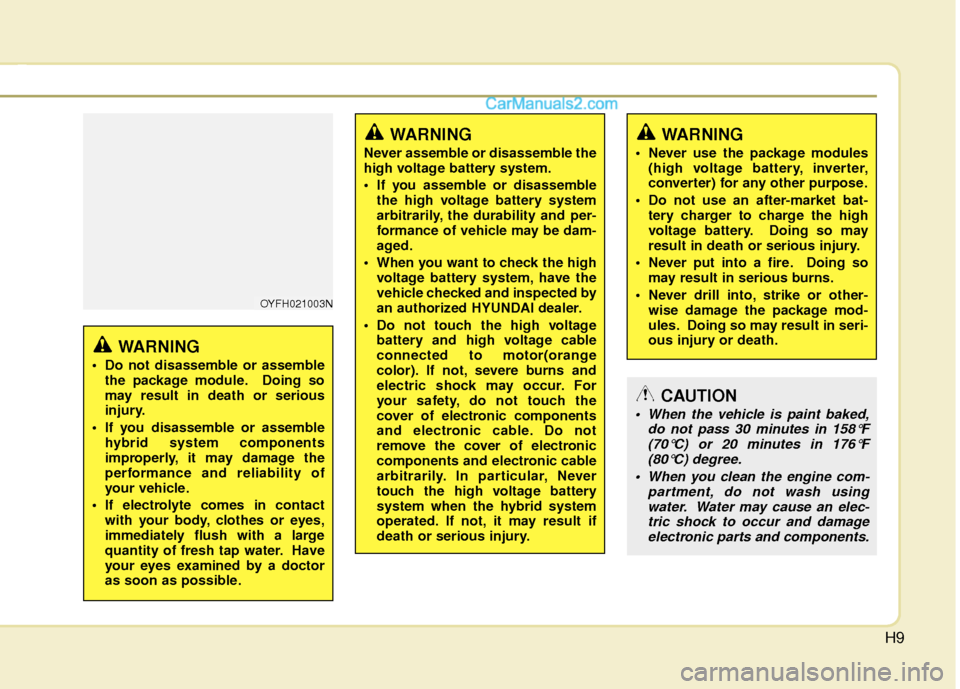
H9
WARNING
Do not disassemble or assemblethe package module. Doing so
may result in death or serious
injury.
If you disassemble or assemble hybrid system components
improperly, it may damage the
performance and reliability of
your vehicle.
If electrolyte comes in contact with your body, clothes or eyes,
immediately flush with a large
quantity of fresh tap water. Have
your eyes examined by a doctor
as soon as possible.
WARNING
Never assemble or disassemble the
high voltage battery system.
If you assemble or disassemblethe high voltage battery system
arbitrarily, the durability and per-
formance of vehicle may be dam-
aged.
When you want to check the high voltage battery system, have the
vehicle checked and inspected by
an authorized HYUNDAI dealer.
Do not touch the high voltage battery and high voltage cable
connected to motor(orange
color). If not, severe burns and
electric shock may occur. For
your safety, do not touch the
cover of electronic components
and electronic cable. Do not
remove the cover of electronic
components and electronic cable
arbitrarily. In particular, Never
touch the high voltage battery
system when the hybrid system
operated. If not, it may result if
death or serious injury.
OYFH021003N
WARNING
Never use the package modules(high voltage battery, inverter,
converter) for any other purpose.
Do not use an after-market bat- tery charger to charge the high
voltage battery. Doing so may
result in death or serious injury.
Never put into a fire. Doing so may result in serious burns.
Never drill into, strike or other- wise damage the package mod-
ules. Doing so may result in seri-
ous injury or death.
CAUTION
When the vehicle is paint baked, do not pass 30 minutes in 158°F(70°C) or 20 minutes in 176°F(80°C) degree.
When you clean the engine com- partment, do not wash usingwater. Water may cause an elec-tric shock to occur and damageelectronic parts and components.
Page 391 of 403

H10
Service plug
This service plug (1) located in the rear
trunk as shown should always be pulled
out to disconnect and turn off the hybrid
system.
IMPORTANT: Wait 5 minutes after this
lever is disconnected to work on the
car to assure all remaining charge in
the system has dissipated.
THE COMPONENTS OF HYBRID VEHICLE (CONT.)
WARNING
This hybrid vehicle uses the hybrid
battery system inverter and con-
verter to generate high voltage.
High voltage in the hybrid battery
system is very dangerous and can
cause severe burns and electric
shock. This may result in serious
injury or death.
For your safety, never touch,replace, dismantle or remove the
hybrid battery system including
components, cables and connec-
tors. Severe burns or electric
shock may result in serious
injury or death if you do not fol-
low this warning.
When the hybrid battery system operates, the hybrid battery sys-
tem can be hot. Always be care-
ful because burns or electric
shock maybe caused by high
voltage.
Do not drop water or liquid to HPCU, HSG, Motor and fuses. The
hybrid system components are
covered, If you drop water or liq-
uid to hybrid system components,
it may result in electronic shock.
WARNING
This plug is attached to the hybrid
battery system, which contains
very dangerous high voltage.
Touching the service lever may
cause severe burns or electric
shock. When you touch it, be care-
ful not to damage.
OYFH061020N
Page 392 of 403
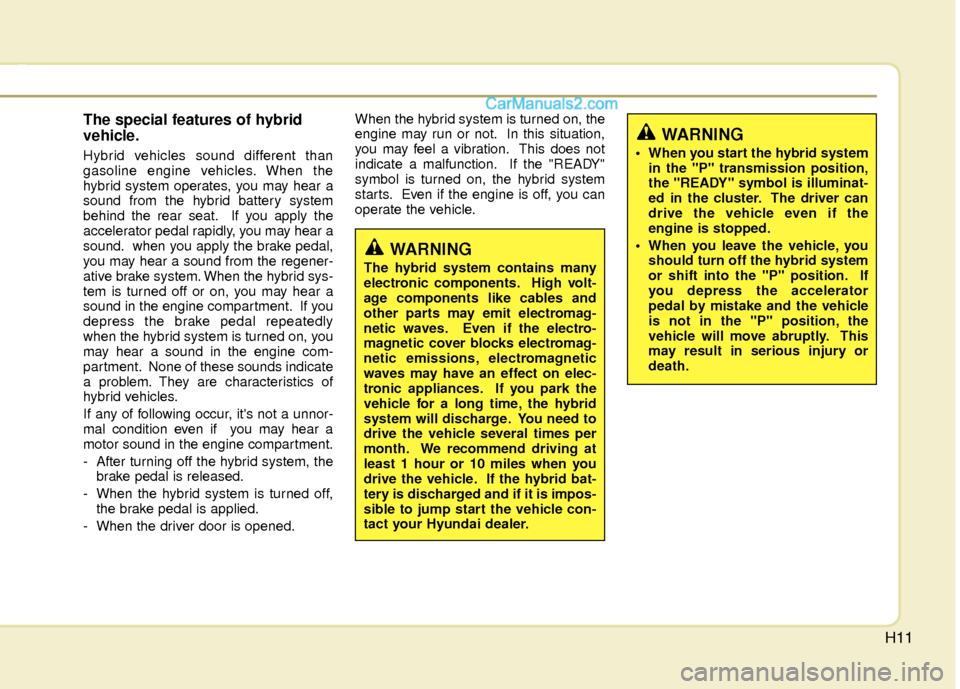
H11
The special features of hybrid
vehicle.
Hybrid vehicles sound different than
gasoline engine vehicles. When the
hybrid system operates, you may hear a
sound from the hybrid battery system
behind the rear seat. If you apply the
accelerator pedal rapidly, you may hear a
sound. when you apply the brake pedal,
you may hear a sound from the regener-
ative brake system. When the hybrid sys-
tem is turned off or on, you may hear a
sound in the engine compartment. If you
depress the brake pedal repeatedly
when the hybrid system is turned on, you
may hear a sound in the engine com-
partment. None of these sounds indicate
a problem. They are characteristics of
hybrid vehicles.
If any of following occur, it's not a unnor-
mal condition even if you may hear a
motor sound in the engine compartment.
- After turning off the hybrid system, thebrake pedal is released.
- When the hybrid system is turned off, the brake pedal is applied.
- When the driver door is opened. When the hybrid system is turned on, the
engine may run or not. In this situation,
you may feel a vibration. This does not
indicate a malfunction. If the "READY"
symbol is turned on, the hybrid system
starts. Even if the engine is off, you can
operate the vehicle.
WARNING
The hybrid system contains many
electronic components. High volt-
age components like cables and
other parts may emit electromag-
netic waves. Even if the electro-
magnetic cover blocks electromag-
netic emissions, electromagnetic
waves may have an effect on elec-
tronic appliances. If you park the
vehicle for a long time, the hybrid
system will discharge. You need to
drive the vehicle several times per
month. We recommend driving at
least 1 hour or 10 miles when you
drive the vehicle. If the hybrid bat-
tery is discharged and if it is impos-
sible to jump start the vehicle con-
tact your Hyundai dealer.
WARNING
When you start the hybrid system
in the "P" transmission position,
the "READY" symbol is illuminat-
ed in the cluster. The driver can
drive the vehicle even if the
engine is stopped.
When you leave the vehicle, you should turn off the hybrid system
or shift into the "P" position. If
you depress the accelerator
pedal by mistake and the vehicle
is not in the "P" position, the
vehicle will move abruptly. This
may result in serious injury or
death.
Page 393 of 403
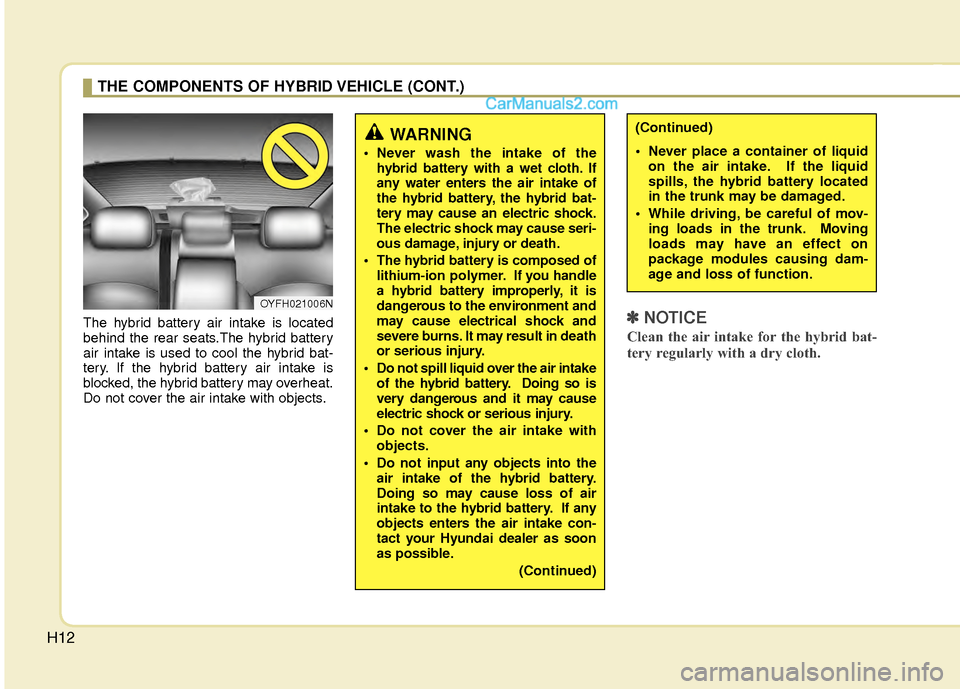
H12
The hybrid battery air intake is located
behind the rear seats.The hybrid battery
air intake is used to cool the hybrid bat-
tery. If the hybrid battery air intake is
blocked, the hybrid battery may overheat.
Do not cover the air intake with objects.✽ ✽NOTICE
Clean the air intake for the hybrid bat-
tery regularly with a dry cloth.
THE COMPONENTS OF HYBRID VEHICLE (CONT.)
WARNING
Never wash the intake of the
hybrid battery with a wet cloth. If
any water enters the air intake of
the hybrid battery, the hybrid bat-
tery may cause an electric shock.
The electric shock may cause seri-
ous damage, injury or death.
The hybrid battery is composed of lithium-ion polymer. If you handle
a hybrid battery improperly, it is
dangerous to the environment and
may cause electrical shock and
severe burns. It may result in death
or serious injury.
Do not spill liquid over the air intake of the hybrid battery. Doing so is
very dangerous and it may cause
electric shock or serious injury.
Do not cover the air intake with objects.
Do not input any objects into the air intake of the hybrid battery.
Doing so may cause loss of air
intake to the hybrid battery. If any
objects enters the air intake con-
tact your Hyundai dealer as soon
as possible.
(Continued)
(Continued)
Never place a container of liquidon the air intake. If the liquid
spills, the hybrid battery located
in the trunk may be damaged.
While driving, be careful of mov- ing loads in the trunk. Moving
loads may have an effect on
package modules causing dam-
age and loss of function.
OYFH021006N
Page 394 of 403
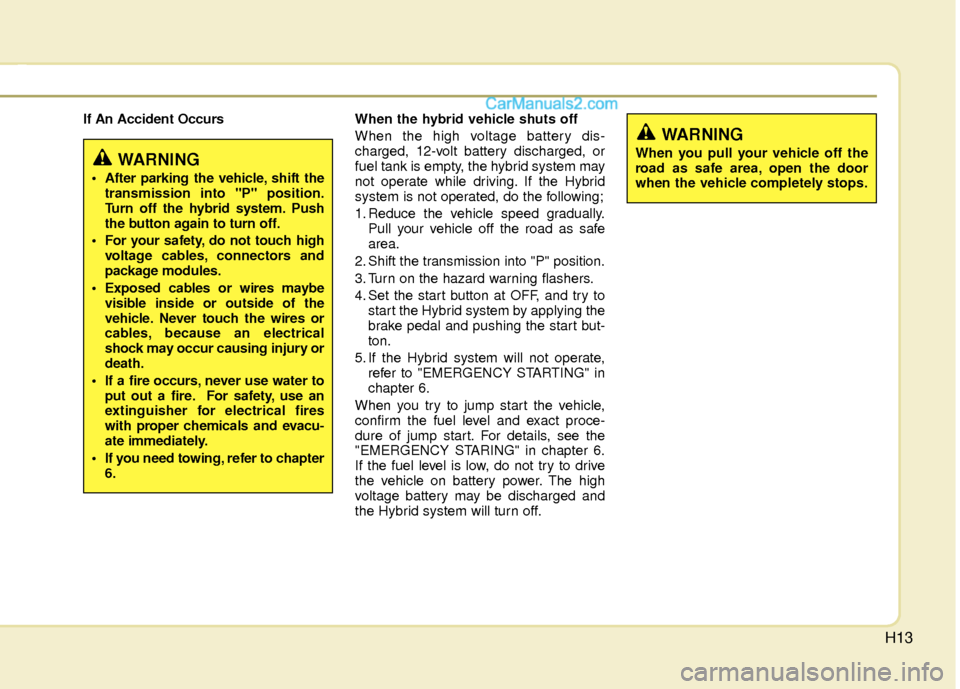
H13
If An Accident OccursWhen the hybrid vehicle shuts off
When the high voltage battery dis-
charged, 12-volt battery discharged, or
fuel tank is empty, the hybrid system may
not operate while driving. If the Hybrid
system is not operated, do the following;
1. Reduce the vehicle speed gradually.
Pull your vehicle off the road as safe
area.
2. Shift the transmission into "P" position.
3. Turn on the hazard warning flashers.
4. Set the start button at OFF, and try to start the Hybrid system by applying the
brake pedal and pushing the start but-
ton.
5. If the Hybrid system will not operate, refer to "EMERGENCY STARTING" in
chapter 6.
When you try to jump start the vehicle,
confirm the fuel level and exact proce-
dure of jump start. For details, see the
"EMERGENCY STARING" in chapter 6.
If the fuel level is low, do not try to drive
the vehicle on battery power. The high
voltage battery may be discharged and
the Hybrid system will turn off.
WARNING
After parking the vehicle, shift the transmission into "P" position.
Turn off the hybrid system. Push
the button again to turn off.
For your safety, do not touch high voltage cables, connectors and
package modules.
Exposed cables or wires maybe visible inside or outside of the
vehicle. Never touch the wires or
cables, because an electrical
shock may occur causing injury or
death.
If a fire occurs, never use water to put out a fire. For safety, use an
extinguisher for electrical fires
with proper chemicals and evacu-
ate immediately.
If you need towing, refer to chapter 6.
WARNING
When you pull your vehicle off the
road as safe area, open the door
when the vehicle completely stops.
Page 396 of 403
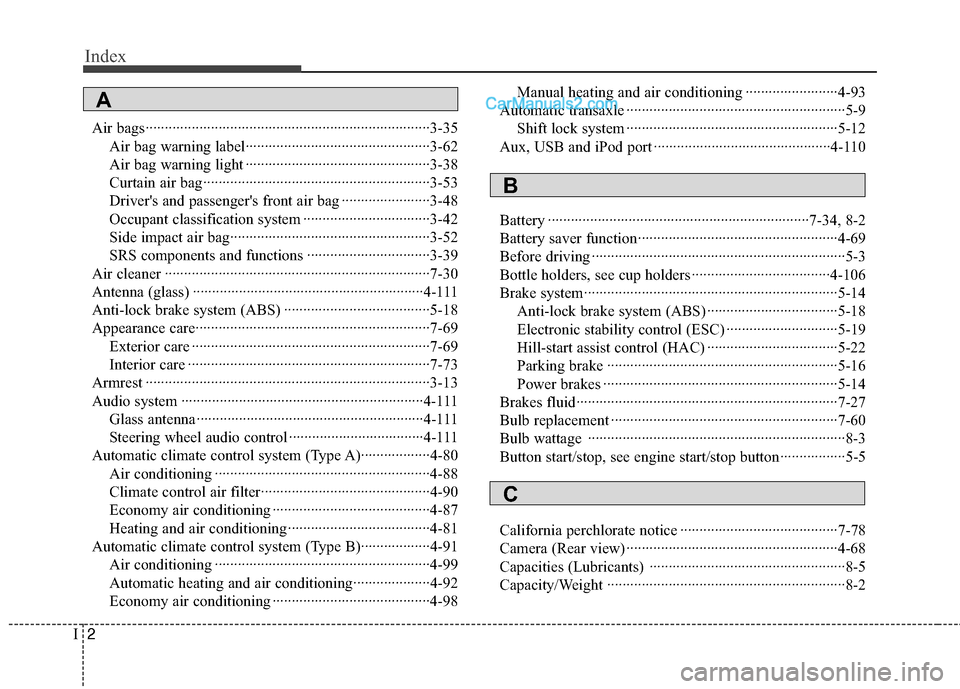
Index
2I
Air bags··················\
··················\
··················\
··················\
··3-35Air bag warning label··················\
··················\
············3-62
Air bag warning light ··················\
··················\
············3-38
Curtain air bag··················\
··················\
··················\
·····3-53
Driver's and passenger's front air bag ··················\
·····3-48
Occupant classification system ··················\
···············3-42
Side impact air bag··················\
··················\
················3-52
SRS components and functions ··················\
··············3-39
Air cleaner ··················\
··················\
··················\
···············7-30
Antenna (glass) ··················\
··················\
··················\
······4-111
Anti-lock brake system (ABS) ··················\
··················\
··5-18
Appearance care··················\
··················\
··················\
·······7-69 Exterior care ··················\
··················\
··················\
········7-69
Interior care ··················\
··················\
··················\
·········7-73
Armrest ··················\
··················\
··················\
··················\
··3-13
Audio system ··················\
··················\
··················\
·········4-111 Glass antenna ··················\
··················\
··················\
·····4-111
Steering wheel audio control ··················\
·················4-111
Automatic climate control system (Type A)··················\
4-80 Air conditioning ··················\
··················\
··················\
··4-88
Climate control air filter··················\
··················\
········4-90
Economy air conditioning ··················\
··················\
·····4-87
Heating and air conditioning··················\
··················\
·4-81
Automatic climate control system (Type B)··················\
4-91 Air conditioning ··················\
··················\
··················\
··4-99
Automatic heating and air conditioning··················\
··4-92
Economy air conditioning ··················\
··················\
·····4-98 Manual heating and air conditioning ··················\
······4-93
Automatic transaxle ··················\
··················\
··················\
···5-9 Shift lock system ··················\
··················\
··················\
·5-12
Aux, USB and iPod port ··················\
··················\
··········4-110
Battery ··················\
··················\
··················\
··············7-34, 8-2
Battery saver function··················\
··················\
················4-69
Before driving ··················\
··················\
··················\
············5-3
Bottle holders, see cup holders ··················\
··················\
4-106
Brake system··················\
··················\
··················\
············5-14 Anti-lock brake system (ABS) ··················\
················5-18
Electronic stability control (ESC) ··················\
···········5-19
Hill-start assist control (HAC) ··················\
················5-22
Parking brake ··················\
··················\
··················\
······5-16
Power brakes ··················\
··················\
··················\
·······5-14
Brakes fluid··················\
··················\
··················\
··············7-27
Bulb replacement ··················\
··················\
··················\
·····7-60
Bulb wattage ··················\
··················\
··················\
·············8-3
Button start/stop, see engine start/stop button·················5-5
California perchlorate notice ··················\
··················\
·····7-78
Camera (Rear view) ··················\
··················\
··················\
·4-68
Capacities (Lubricants) ··················\
··················\
···············8-5
Capacity/Weight ·················\
··················\
··················\
·········8-2
A
B
C
Page 399 of 403

I5
Index
GaugeEngine temperature gauge··················\
··················\
·····4-42
Fuel gauge ··················\
··················\
··················\
···········4-43
Glass antenna ··················\
··················\
··················\
·········4-111
Glove box··················\
··················\
··················\
···············4-105
Hazard warning flasher··················\
··················\
··············4-68
Hazardous driving conditions ··················\
··················\
····5-30
Headlight bulb replacement ··················\
··················\
·······7-60
Headrest ··················\
··················\
··················\
············3-7, 3-11
Highway driving ··················\
··················\
··················\
······5-33
Homelink mirror, see the Electric chromic mirror (ECM) with HomeLink system ··················\
··················\
·········4-31
Hood··················\
··················\
··················\
··················\
·······4-21
Horn ··················\
··················\
··················\
··················\
·······4-30
How to use this manual ··················\
··················\
···············1-2
Hybrid HMC Hybrid system··················\
··················\
················H2
State of charge (SOC) ··················\
··················\
··············H3
Sonata hev energy flow ··················\
··················\
··H4, 4-45
The componets of hybrid vehicle ··················\
··············H7
The air intake of hybrid battery ··················\
···············H12
The READY indicator··················\
··················\
···········4-41
The ECO level··················\
··················\
················H2, 4-47\
The EV MODE ··················\
··················\
··················\
···4-53 The service indicator ··················\
··················\
·············4-53
The ECO GUIDE ··················\
··················\
··················\
4-43
Hybrid electric vehicle··················\
··················\
···············4-45
Immobilizer system ··················\
··················\
··················\
···4-7
Indicator symbols on the instrument cluster ··················\
·1-7
Indicators and warnings ··················\
··················\
·············4-53
Inside rearview mirror ··················\
··················\
···············4-31
Instrument cluster ··················\
··················\
··················\
····4-40 Engine temperature gauge··················\
··················\
·····4-42
Fuel gauge ··················\
··················\
··················\
···········4-43
Hybrid electric vehicle ··················\
··················\
··········4-45
Instrument panel illumination ··················\
·················4-41\
Odometer ··················\
··················\
··················\
·············4-41
Speedometer ··················\
··················\
··················\
········4-42
Trip computer ··················\
··················\
··················\
······4-44
Warning and indicators ··················\
··················\
·········4-53
Instrument panel fuse··················\
··················\
·················7-51\
Instrument panel illumination··················\
··················\
····4-41
Instrument panel overview ··················\
··················\
··········2-3
Interior care··················\
··················\
··················\
··············7-73
Interior features··················\
··················\
··················\
······4-106 Aux, USB and iPod port ··················\
··················\
·····4-110
Clothes hanger··················\
··················\
··················\
···4-109
Cup holder ··················\
··················\
··················\
·········4-106
Digital clock ··················\
··················\
··················\
······4-108
Floor mat anchor(s) ··················\
··················\
·············4-109
G
I
H